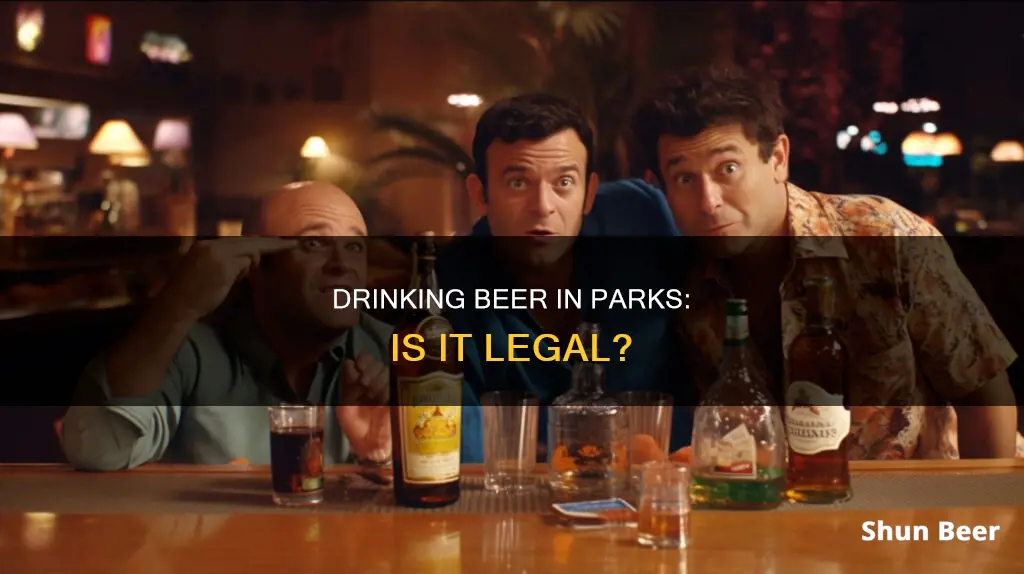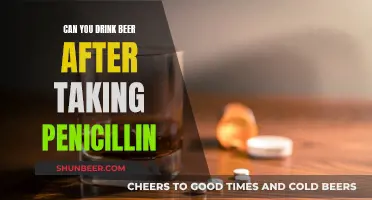
Drinking in parks and other public spaces is a divisive topic, with laws and social norms varying significantly across the world. While some countries and states have strict restrictions on public alcohol consumption, others adopt a more relaxed approach, allowing drinking in designated areas or under certain conditions. In the US, for instance, public drinking laws differ from state to state, and even from park to park, with some states imposing outright bans, while others permit drinking in specific entertainment districts or parks. Outside the US, countries like Norway, Poland, India, and Sri Lanka generally frown upon public drinking, while it's socially acceptable in places like Denmark, Portugal, Spain, Germany, and the UK.
What You'll Learn

Where is drinking in public legal?
Drinking in public places, including sidewalks, parks, stadiums, and beaches, is considered illegal in most jurisdictions in the United States. However, there are some places where drinking in public is legal. Here is a list of some places where drinking in public is permitted:
Gainesville, Florida
Gainesville, Florida, allows the consumption of alcoholic beverages in public.
Indiana
Indiana has no restriction on carrying open containers of alcohol on public premises. You can even keep your drink in its original container, unlike in many other states. However, be mindful that local ordinances may not allow this, and the alcohol-serving business may not either.
Hood River, Oregon
The city of Hood River, Oregon, allows the consumption of alcoholic beverages in public.
Butte, Montana
Butte, Montana, is the one town in the country that allows people to drink anything they want, anywhere they want. However, open containers are prohibited between 2 a.m. and 8 a.m.
New Orleans, Louisiana
New Orleans, Louisiana, is well-known for its free-drinkin' mentality. The city allows the possession and consumption of any alcoholic beverage in an open plastic container or plastic cup on the street. Additionally, open container restrictions are suspended during Mardi Gras.
Birmingham, Huntsville, Mobile, Montgomery, and Tuscaloosa, Alabama
These cities in Alabama have approved entertainment districts where public drinking is permitted. However, there are extra stipulations in some cities. For example, in Mobile, you must have "open plastic containers with a commercially printed name and/or logo of a designated licensee."
Tampa, Florida
The city of Tampa, Florida, allows up to two drinks in plastic containers per person on the Tampa Riverwalk, purchased from one of the licensed facilities, between 11 a.m. and 1 a.m.
Savannah, Georgia
The city of Savannah, Georgia, permits public consumption of alcohol.
Colorado
In Colorado, you can drink alcohol in public areas such as state or city parks, as long as the drink contains 3.2% or less alcohol by volume (ABV).
Kansas City, Missouri
In the Power & Light District of Kansas City, a special state law allows the possession and consumption of alcoholic beverages on the street in open plastic containers.
Las Vegas, Nevada
In unincorporated Clark County, Nevada, including the Las Vegas Strip, you can possess and consume alcoholic beverages on the street, except within parking lots or within 1,000 feet of the store from which it was purchased if the alcohol was bought in a closed container. Additionally, you can carry a drink on the Las Vegas Strip as long as it's in a plastic, paper, or aluminum container.
Dalton, Georgia
The city of Dalton, Georgia, permits public consumption of alcohol within a designated 80-acre area downtown.
Ohio
Since 2015, Ohio has allowed cities to create "designated outdoor refreshment areas" (DORA) where alcoholic beverages are permitted. Cities that have created these districts include Canton, Delaware, Hamilton, Lancaster, Logan, Lorain, Middletown, and Toledo.
Michigan
In 2020, Michigan allowed cities to grant social district permits for the open consumption of alcohol.
Mississippi
Historically, Mississippi has had strict alcohol laws, but today, there is no state-wide law against public drinking, and no open container laws. However, public intoxication is a crime. Additionally, Mississippi is one of 11 states where open container laws don't apply. It is technically legal to drink an alcoholic beverage while driving, as long as you are under the legal limit.
Tampa, Florida
The city of Tampa, Florida, allows up to two drinks in plastic containers per person on the Tampa Riverwalk, purchased from one of the licensed facilities, between 11 a.m. and 1 a.m.
Drinking Non-Alcoholic Beer in Public: Is It Okay?
You may want to see also

Where is drinking in public illegal?
The laws regarding drinking in public vary across the world. In some countries, drinking in public is almost universally condemned or outlawed. In other countries, drinking in public is socially acceptable. Here is a list of places where drinking in public is illegal:
United States
Drinking in public places, including sidewalks, parks, stadiums, and beaches, is considered illegal in most jurisdictions in the US. While many states have banned drinking in public spaces, some cities or select entertainment districts, like the Las Vegas Strip, allow it. Additionally, some states don't have a specific law against public drinking, but most cities or counties do.
Canada
In Canada, except for Quebec, possession of open containers of alcohol in public is generally prohibited outside of private residences or licensed premises. In Ontario and British Columbia, the penalty for possession or consumption of liquor in a public place is a fine.
Chile
While Chile has one of the highest alcohol consumption rates in the Americas, public drinking is generally prohibited, except during New Year's Eve.
China
Despite having a strong drinking culture, China has "lax" alcohol regulations, and drinking in public is widely accepted.
Colombia
In 2018, public alcohol consumption was banned in Colombia. However, in 2019, the Supreme Court overturned this ban, allowing people to drink in public again.
Norway
Drinking in public in Norway is illegal and subject to fines. While drinking in parks is common, it is not legal, and police officers will usually ask the drinker to empty the bottle.
Poland
Since 2018, drinking in public has been illegal in Poland, and the police strictly enforce this law. Municipal authorities may permit drinking in designated areas.
Singapore
In Singapore, drinking in public is restricted from 10:30 pm to 7:00 am. A permit is required to consume alcohol during these restricted hours in public places.
United Kingdom
In the UK, drinking in public is generally legal, but local laws may ban public drinking in certain areas or at certain times. In Scotland, each council has its own bylaws regarding public alcohol consumption.
India
Drinking in public is quite unusual in India, and one may not openly carry and consume a bottle of alcohol on the streets. However, it is common to see people drinking in areas with bars or wine stores.
Mexico
In Mexico, drinking in public is mostly illegal and regulated at the municipal level. While it is socially accepted and tolerated by authorities in certain neighbourhoods or communities, public drunkenness is punishable by law.
New Zealand
While drinking in public is legal in New Zealand, local authorities can declare liquor-free zones where alcohol consumption is prohibited in public areas but allowed on licensed premises and private property.
Drinking Beer in Venice: What's Allowed in Public?
You may want to see also

What are the penalties for drinking in public where it's not allowed?
The penalties for drinking in public where it is not allowed vary depending on the location and the nature of the offence. In some countries, such as Norway, Poland, India, Sri Lanka, and several U.S. states, public drinking is almost universally condemned or outlawed. In other countries, such as Denmark, Portugal, Spain, Germany, the United Kingdom, and New Zealand, it is socially acceptable.
In the United States, drinking in public places—including sidewalks, parks, stadiums, and beaches—is considered illegal in most jurisdictions. Penalties can range from steep fines to jail time. For example, in Illinois, public drinking and carrying alcohol openly can be charged as a Class B misdemeanour, with offenders facing up to six months in prison and a fine of $100 to $500. In Chicago, it is unlawful for any person to drink alcoholic liquor in public or in a motor vehicle, and the transportation or possession of alcoholic liquor in a motor vehicle is also prohibited unless it is in its original, sealed package.
In the United Kingdom, public drinking is generally legal in England and Wales, but there are certain public places where drinking is not allowed, and police may request that individuals stop drinking and surrender their alcohol. In Scotland, each council has its own bylaws concerning public alcohol consumption, with some regions imposing fines for drinking in public places.
In Canada, except for Quebec, possession of open containers of alcohol in public is generally a violation of provincial acts and municipal bylaws. In British Columbia and Ontario, the penalty for possession or consumption of liquor in a public place is a fine. In Quebec, the laws are more relaxed, and alcohol may be consumed in public parks when accompanied by food.
In Australia, each state and territory has its own laws governing the use and service of alcohol. In Victoria, public drunkenness is no longer a criminal offence, but there are still laws and consequences for drinking in a public place, including fines, imprisonment, or disqualification from driving.
Other countries have their own unique approaches to public drinking and the associated penalties. For example, in Brazil, drinking publicly is legal and socially accepted, but DUI laws are enforced, and offenders may lose their license. In Belgium, drinking in public is legal, but some cities have local ordinances that make it illegal in certain areas, with potential fines of up to €350. In China, drinking in public is widely accepted, and there are no laws against it, with alcohol sold everywhere from convenience stores to street stalls.
Drinking Beer on Caltrain: What You Need to Know
You may want to see also

What are the social norms around drinking in public?
Social norms around drinking in public vary significantly across the world. While some countries have a more relaxed attitude towards drinking in public spaces, others have strict laws prohibiting it. Drinking in public is often defined as drinking in outdoor spaces such as roads, walkways, and parks, excluding bars, restaurants, stadiums, and other such establishments.
In countries like Norway, Poland, India, Sri Lanka, and some Muslim-majority countries, public drinking is generally condemned or outlawed. These countries often have cultural, religious, or governmental opposition to public alcohol consumption. On the other hand, countries like Denmark, Portugal, Spain, Germany, the United Kingdom, New Zealand, Japan, Finland, and China accept and normalize drinking in public spaces.
Even within countries, there can be variations in the social norms and legalities of drinking in public. For example, in the United States, each state has its own open container laws, and public drinking is prohibited in most jurisdictions. However, some states like Georgia, Louisiana, Missouri, Montana, Nevada, and Pennsylvania do not actively ban public drinking, leaving the decision to individual municipalities. Similarly, in Canada, Quebec has more relaxed laws than other provinces, with Montreal's Mount Royal being a popular spot for public drinking.
Drinking in public parks is a specific area of interest for many people. In Europe, countries generally have more relaxed open-container laws, and drinking in parks is often permitted. However, in the United States, the rules differ from state to state and even from park to park. For instance, in California, many parks in the Bay Area, such as Golden Gate Park and Lake Temescal, allow wine and beer but prohibit hard liquor and glass containers. In Colorado, drinking in public parks is permitted as long as the beverage contains 3.2% alcohol or less by volume.
The social norms around drinking in public are shaped by cultural attitudes, religious beliefs, and governmental regulations. While some societies view public drinking as a social and cultural staple, others associate it with negative consequences such as overconsumption, rowdiness, violence, and environmental concerns. Ultimately, the norms and laws regarding public drinking vary widely, and it is essential to be aware of and respect the local regulations in your area.
Exploring Jordan's Beer Culture and Drinking Laws
You may want to see also

What are the arguments for and against drinking in public?
The social customs and laws concerning drinking alcohol in public vary significantly across the world. While drinking in public is socially acceptable in some countries, it is condemned or outlawed in others. Here are some of the common arguments for and against drinking in public:
Arguments for Drinking in Public:
- Proponents of drinking in public argue that it does not cause problems such as overconsumption and violence. Instead, they believe that social issues are the root cause of these problems, and countries that allow public drinking can have low levels of associated issues.
- Drinking in public can help normalize attitudes towards alcohol and contribute to a healthier drinking culture.
- In some countries, drinking in public spaces is a part of their cultural traditions and festivals. For example, in Japan, drinking in public is a common custom during local festivals and cherry blossom viewing.
- Drinking in public spaces can be a source of revenue for cities and states, especially in the entertainment and tourism sectors. After the COVID-19 pandemic, some states relaxed their public drinking laws to recoup lost revenue.
Arguments Against Drinking in Public:
- Opponents of public drinking, such as religious organizations and governmental agencies, argue that it encourages overconsumption of alcohol, binge drinking, rowdiness, and violence. They suggest that drinking in controlled environments like bars or clubs is preferable, as it is easier to prevent overconsumption and manage rowdy behaviour.
- Drinking in public spaces increases the risk of public inebriation, which can lead to issues such as aggressive behaviour, broken glass bottles on streets, and littering. Alcoholic beverage containers, especially broken glass bottles, can cause environmental harm and be a safety hazard for wildlife and cyclists.
- Drinking in public can lead to increased alcohol accessibility for minors, which can have negative health and social consequences.
- In some countries, drinking in public spaces is considered a violation of religious or cultural norms, especially in Muslim-majority countries.
Ginger Beer: A Beginner's Guide to Drinking It
You may want to see also
Frequently asked questions
Drinking in public places, including parks, is considered illegal in most jurisdictions in the U.S. However, some states don't have a specific law on the books, and a few even allow it.
Penalties for drinking beer in a park range from hundreds of dollars in fines to jail time in some places.
Yes, there are a few places where drinking beer in the park is permitted or tolerated. For example, in New Orleans, public consumption of alcohol is allowed, and all rules are suspended during Mardi Gras. In Colorado, drinking in public parks is permitted as long as the beverage contains 3.2% alcohol or less. In New York City, while public drinking is illegal, it is rarely enforced during free concerts in parks, and discrete drinkers are usually left alone.







